Black Friday 2025 has landed at Analogue Wonderland, bringing some of our biggest film photography deals of the year - from discounted film and cameras to money-saving WonderLab processing offers, exclusive bundles, and festive specials available for a limited time only. Grab a great deal while stocks last!
Recent posts
Shop the article
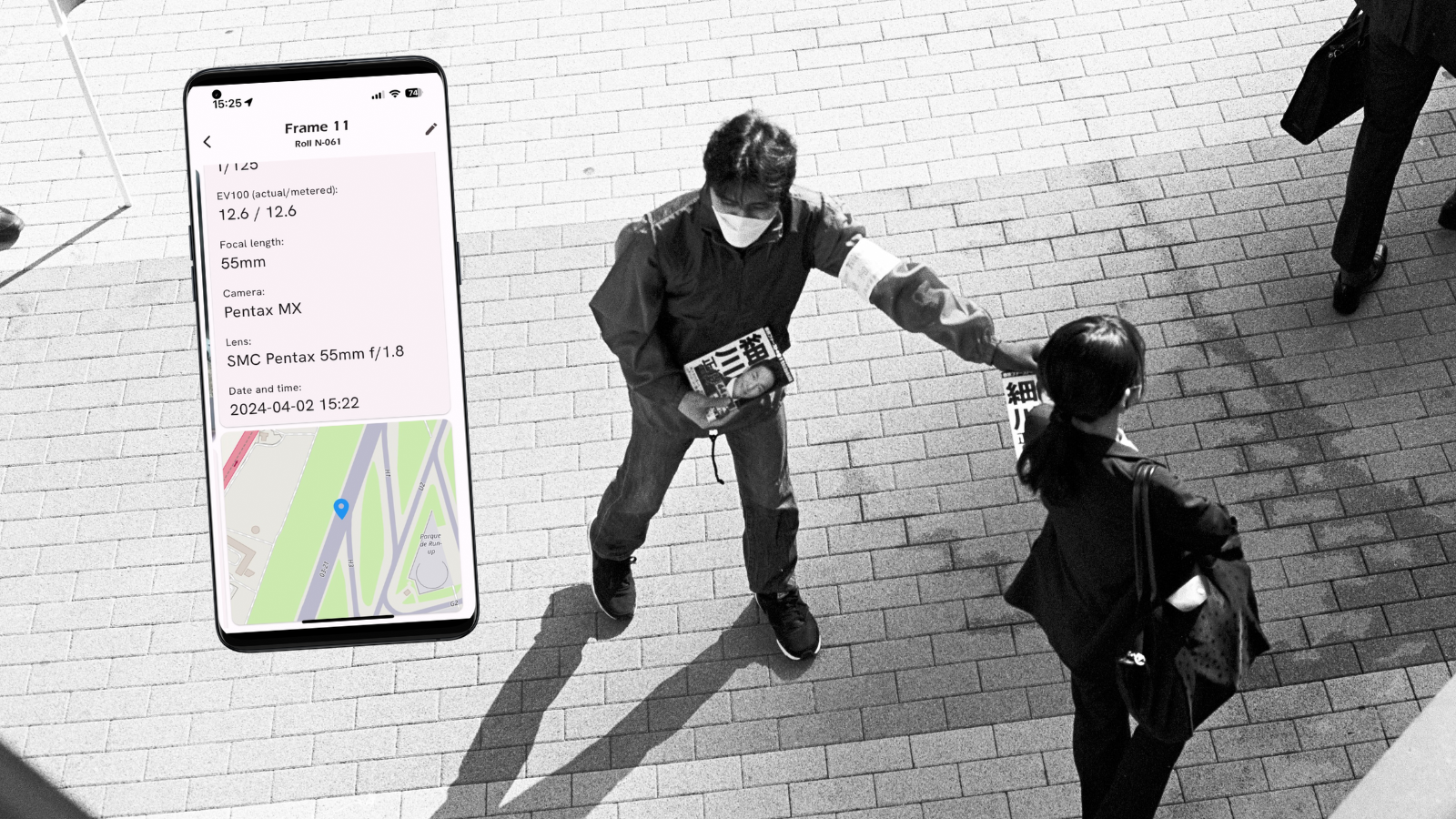
Digital Notes for Analogue Photographers
Many analogue photographers don’t bother taking notes on the images we take. But there is so much valuable information either locked up in our heads or, more likely, lost to time that we could be leveraging to improve our skills and our images. As well as understanding when cameras need a repair! Taking notes by hand is seen (rightly!) as tedious, time consuming, and low-value. But it’s only low-value if you never use it, and the value of this information increases dramatically with volume. The tedium problem is real, though.
As a long-time veteran of Silicon Valley, I thought perhaps I could apply my skills designing great user experiences to removing the tedium of note taking by automating it away. My name is Don Goodman-Wilson and Crown + Flint is the app I designed to overcome the challenge and help photographers unlock the power of metadata. And please forgive any American spellings in what follows!
Why documenting matters
For viewers of a photograph, there’s little that matters more than the image itself, and perhaps a title or something to give the image some context (maybe). But as photographers, we often like to know more about the technical context of a photo—information about the lens and camera, the exposure, the film stock and development.
There’s a lot to be learned from this kind of data, especially as we experiment with something new. Digital cameras and workflows capture most of this data automatically, but with analogue photography we have to rely on notes made by hand.
Do you record notes about the photos you take? I have generally always wanted to. I started with pen and paper, meticulously recording the general location, lens, shutter speed, focal length, all that. That lasted about two rolls. I didn't have the patience for it - although I know there are plenty of people who do!

Now what aperture had I set...
And then for the next decade I didn't write anything down. So now I have a binder full of film, of which I can only guess which film camera and lens I used. The settings are a total mystery. In some cases even the film is a total mystery (because of the lack of edge markings). So what? Why bother collecting metadata on our film shots? This is a great question, and one I was struggling with.
For me, the answer began a few years back when I bought my first serious digital camera. It records everything, even GPS data (using a companion app on my phone). Having this data was a revelation to me. Because with this data I can do so many more things I couldn't before.
- I use Apple Photos to manage my personal photos (after editing), and I can search by camera body, lens, setting, location, date—and I can find my images really quickly this way.
- I have insights now into how I use my equipment, for example which lenses and focal lengths are my favourite.
- I know my equipment better, such as which lenses fall apart wide open.
- I can catch faults in my equipment, like if the shutter is off at certain speeds.
- I have better knowledge of how my film stocks perform, and a record of how I developed them (once I started taking notes on my film shots again, that is).
I knew if I was going to collect this information for my film photography, I couldn't rely on pen and paper. The world had advanced, and we all have powerful computers in our pockets. I needed an app.
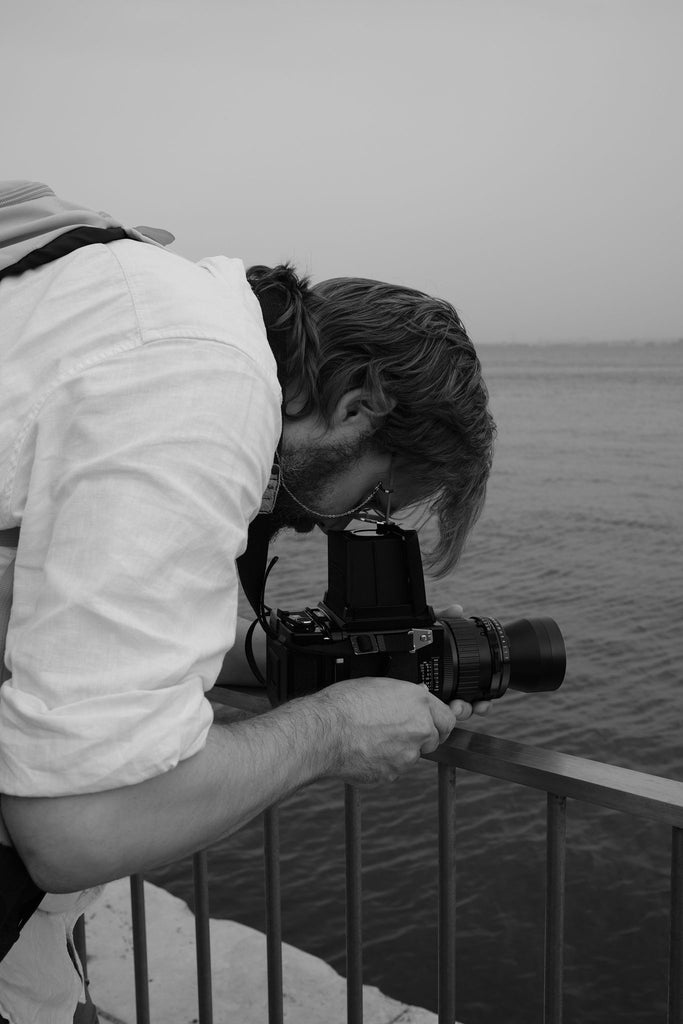
Don Goodman-Wilson at work! Taken by Afonso Fan
Unfortunately, most of the apps I tried were little better than taking notes with a pen and paper. Every shot was an exercise in tedious data entry. I knew the experience could be better. So I wrote my own app, Crown + Flint.
My primary goal with Crown + Flint was to collect as much information as I possibly could, as simply and efficiently as possible. My benchmark was my Sekonic L-308X—the app must be no more obtrusive to use than a handheld light meter, and ideally it should be less obtrusive. I think I've succeeded.
The app started as a project just for me, but as I began sharing it with other film photographers and gathering their feedback, I was able to transform it into something not merely useful, but something I'm quite proud of. The first version was released in August 2023, and in the intervening eight months I've made three additional releases adding community-requested features. And I've got a massive list of features still to implement.
Rather than demand you change the way you photograph, Crown + Flint is designed to fit seamlessly into a photographer's existing workflows. It has three primary functions—metadata collection (the most important!) film stock and archive management, and equipment management.
Metadata collection
This is the heart of the app, the most important part. It looks and acts like a light meter app, but there's so much more going on under the hood. The light meter knows what camera you're using, what lenses you have available for that camera, and what film stock you're shooting. Unlike dedicated light meters like the Sekonic or most light meter apps, Crown + Flint knows about your equipment, and it will never suggest impossible combinations of camera settings.
The light meter interface is designed to be familiar to those who have used needle-match light meters before. Crown + Flint uses your device's camera to suggest a light meter reading as an exposure value, just like many light meters you may have used before—that's one needle. Then you align the second needle by choosing appropriate camera settings on the left.
The key difference is that, unlike most hand-held or in-camera meters that offer relatively primitive methods to evaluate the scene, Crown + Flint uses your smartphone's native intelligent evaluative metering to make sure that shadows retain detail, while the rest of the scene remains in balance. You can touch anywhere on the screen to adjust the exposure, no need for manual exposure compensation. And if you don't like the reading…you're free to use whatever camera settings you like to compensate.
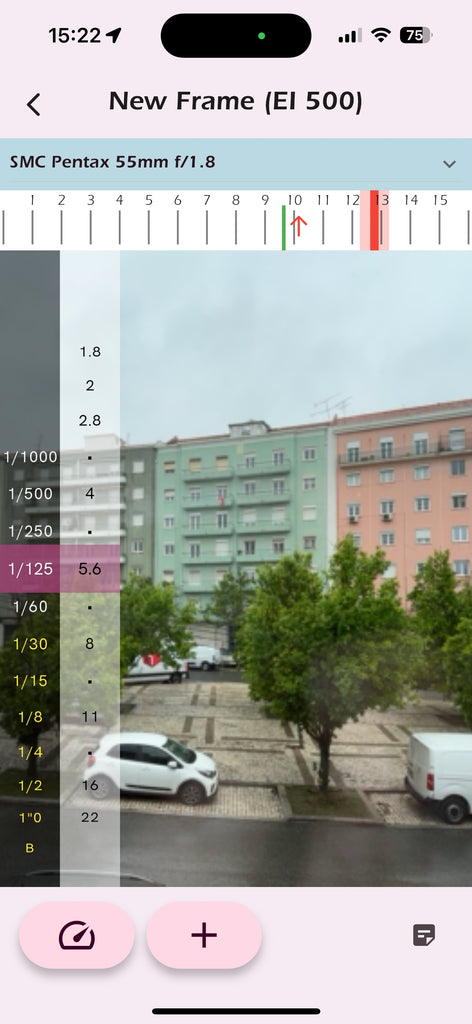
Capturing an image with my Pentax ME Super and SMC Pentax 55m f/1.8. It's a rainy day but still bright. I need to stop down a bit to avoid over-exposure
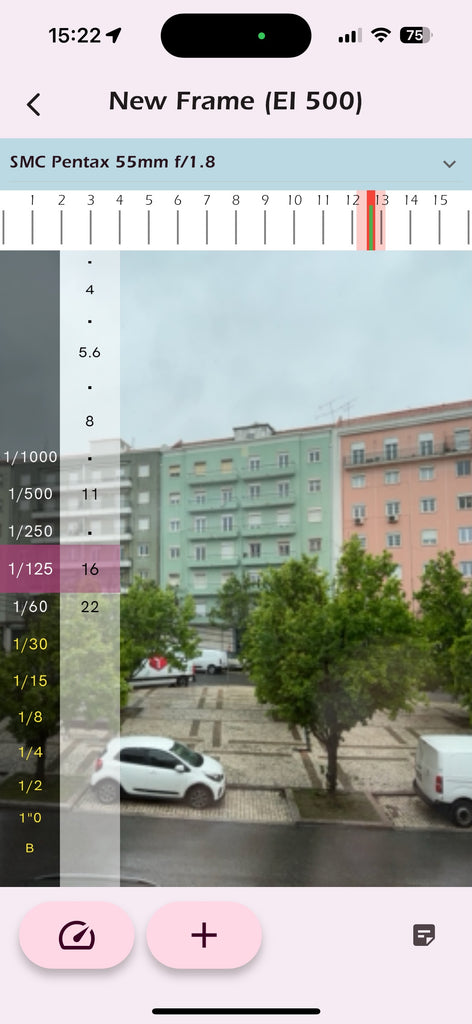
F/16 ought to do it
Once you take a meter reading and set the shutter speed and aperture, Crown + Flint records the camera settings, the lens you used and the focal length, the meter reading, the time and date, your geolocation, and a reference image so you can match up the metadata later.
When you're done with a roll, you can export the data you've collected for use with ExifTool if you're technically inclined, or a new Lightroom plugin written by a Crown + Flint user. Additional ways to get the metadata out of the app and into your film scans are coming.
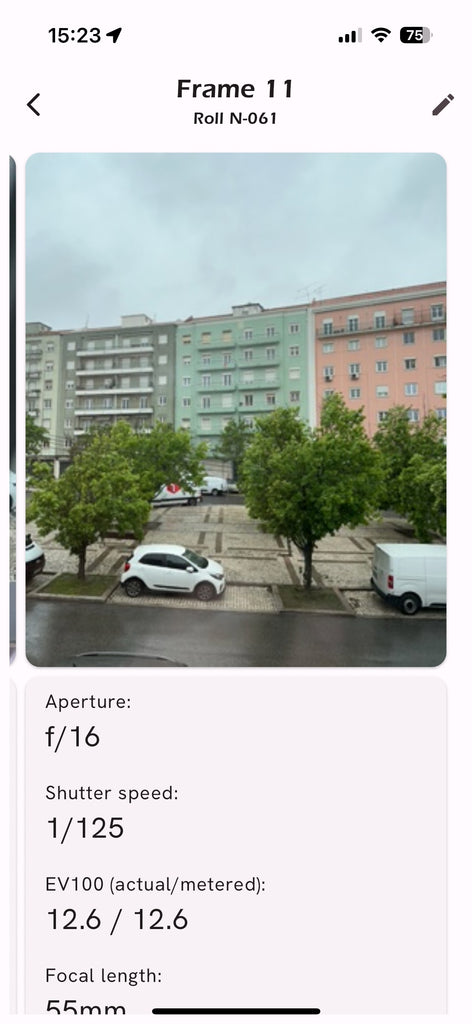
Now I've got a reference image, and exposure information…

…along with information about the equipment used, the date and time, and the physical location. Of course I also have the film stock and exposure index as well.
Film management
Do you have a big inventory of camera film in your fridge? Binders full of cut film? Crown + Flint helps you manage all that. You can manage not only what kind of film you have, but how much, when it expires, and where you keep it. Crown + Flint will even help you estimate how much is left in your bulk rolls as you spool fresh cartridges.
You can also see at a glance what films are loaded into your cameras, what films are out at the lab, and of course your entire archive of developed film. Sort and filter by a range of useful criteria to find what you're looking for, and learn about your shooting habits.
And once film has been shot, you can track the development of your film. Leave yourself notes on your development process for each film too. Then peruse all your entire film archive from your phone, so you don't have to hunt through binders to find that specific frame you want to print.
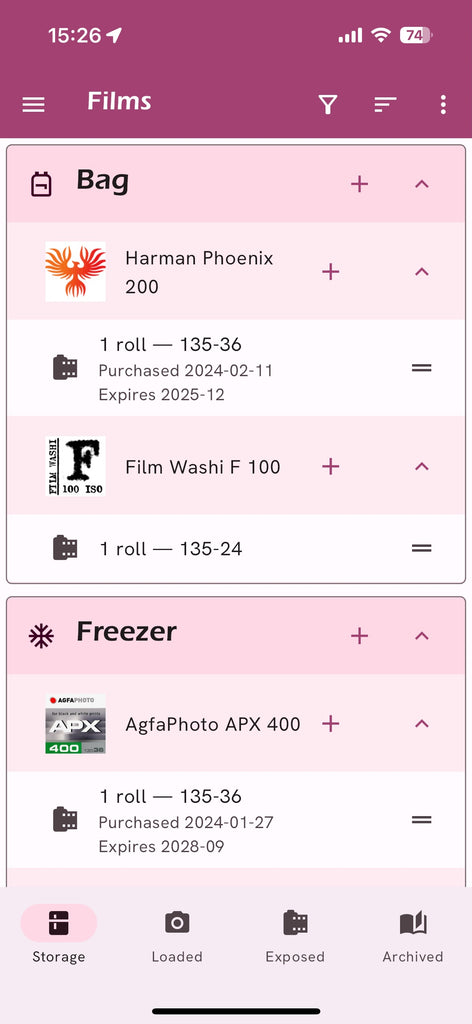
I've got a couple rolls of film ready to go in my bag, and much more sitting in my freezer.

I do shoot a lot of film at ISO 400, but I don't define myself by the speed I shoot 🧐
That said, at the moment there's no way to import data on your existing film archives, but this is a feature I'm building out now.
Equipment management
The light meter needs to know the available settings on your cameras and lenses, so Crown + Flint has a complete equipment inventory module. Track each of your bodies and lenses with serial numbers, and freeform notes.

I like all kinds of film cameras, but I love Pentaxes
So what?
There's a lot to be said for tracking metadata for your film shots. Having—and looking at!—this data can help you better know your equipment, take better shots with good exposure, improve your developing technique, and learn about yourself and your style in the process.
Here's a sample of how I've improved since, by leveraging the data I've collected in Crown + Flint:
- I know my Sigma Super-Wide 24mm f/2.8 has terrible chromatic aberration wide open, but it doesn't look the worst on black and white film.
- I know my Kyoei W.Acall 35mm f/3.5 is much sharper wide open than I would have ever expected.
- Every shutter speed on all three of the lenses I recently acquired for my RB67 are spot on—much to my surprise.
- I learned my Pentax MX was having shutter issues at high speeds, and needed a CLA.
- Foma Ortho 400 is a great film, but seriously blooms in bright sunlight—it's very easy to over-expose outdoors.
- Fomapan 400 is grainier developed in Rodinal than in Adox XT-3 (my usual go-to developer)—and I like it better that way.
- The way I develop AgfaPhoto APX400 gives a speed closer to 800 than 400.
- I've now got the confidence to do more detailed film stock analysis because I have a central place to store all the data I need to do it.
- I can track the location of all my vacation film photos in Apple Photos, along with my phone snapshots, and find them quickly and easily to share with friends and family.
I think you'll be surprised how much a difference metadata can make to your own skills in, and enjoyment of photography.

Although already on its fourth release, Crown + Flint will always be growing and evolving in response to the needs of analog photographers. At the moment, I’m working on adding support for using lens filters, as well as better ways to get your existing data into and out of Crown + Flint. But I’m also in the planning stages for previewing your lenses field of view, spot metering, recording multiple exposures, and improved note-taking for development.
You can help direct the future of Crown + Flint as a part of the rapidly growing community of users supporting each other on Discord. Crown + Flint is available for download on iPhone and Android. You can try out your first five rolls for free, and if you like it, unlock lifetime full access for €19.99 (no subscription).
Written by:
Don Goodman-Wilson, the creator of the Crown + Flint mobile app
Ready to dive in?
Keep Reading
View all
Christmas 2025: Shipping & Opening Hours
Christmas 2025 is fast approaching! To make sure your analogue goodies arrive in time, take note of our last shipping dates, plus opening and operating hours over the festive season. We've got everything you need to gift the magic of film photography this Christmas!

Film Photography Christmas Gift Guide 2025: Analogue Wonderland
Capture the magic of Christmas with film - no filters needed. Our 2025 Film Photography Christmas Gift Guide 2025 is packed with thoughtful presents for every type of shooter, from curious beginners to seasoned photographers. Discover film stocks, cameras, and creative accessories that will make this festive season truly memorable.
Subscribe to our newsletter 💌
Sign up for our newsletter to stay up to date on film photography news, sales and events:
Free Tracked Shipping
On all UK orders over £50
Passion For Film
An unbeatable range and an on-site lab
Our Customers Trust Us
Thousands of independent 5* reviews
All Deliveries are Carbon Neutral
Independently audited and verified by Planet
- Opens in a new window.




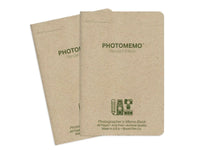
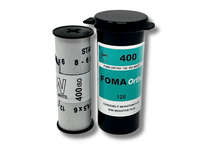


1 Comment -
Heather •
I started taking notes of my shots a few weeks ago as I’m doing a night photography project and I really want to learn in much more detail what works, so I get the best results. I wish I’d started before, currently I’m using the AW little photobooks but I’d love to have an app for this really, but there’s nothing out there that’s quite right.